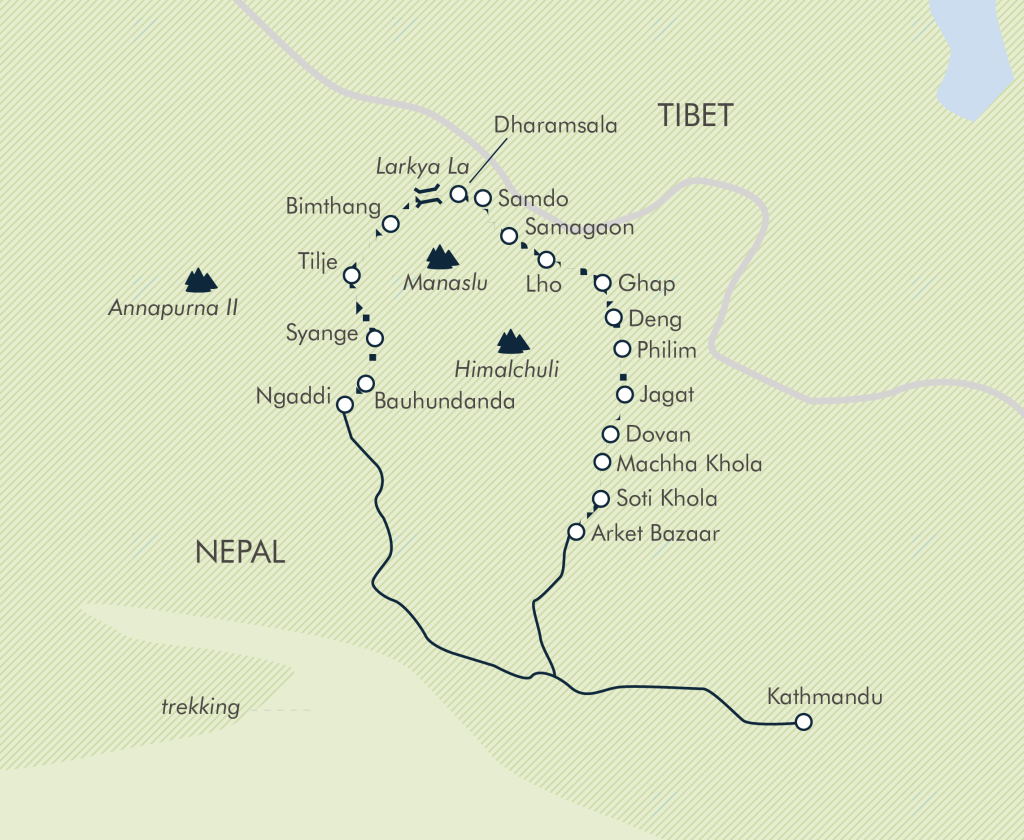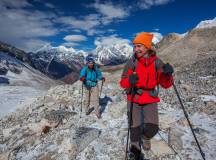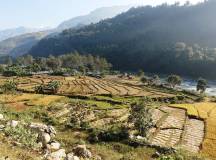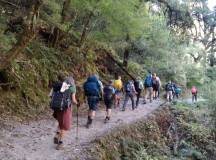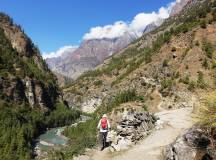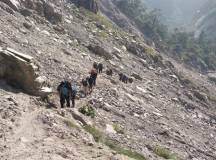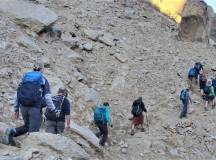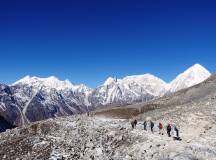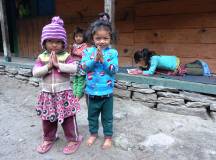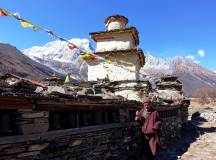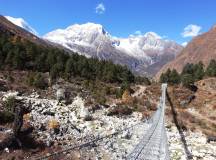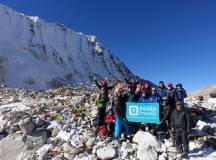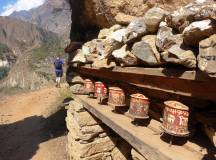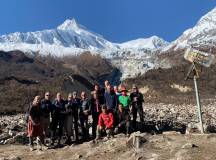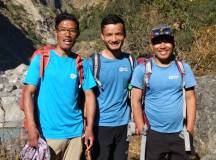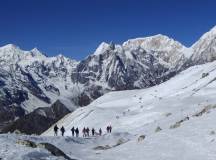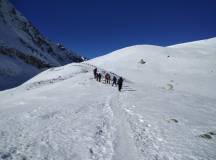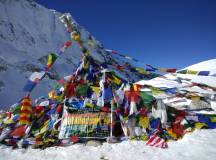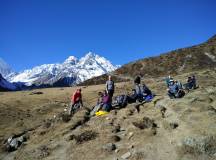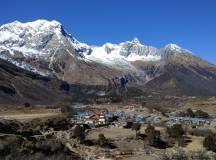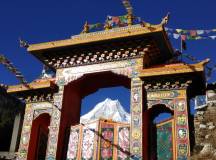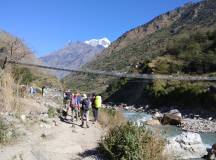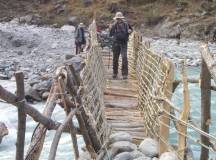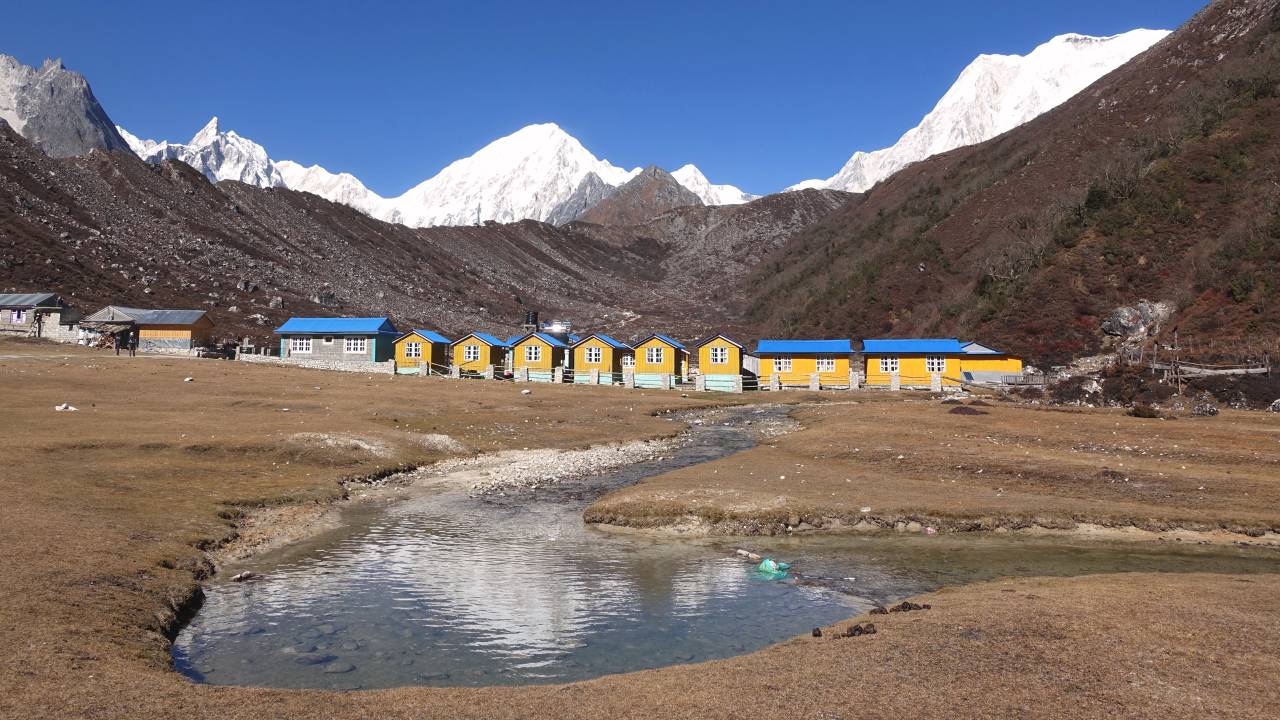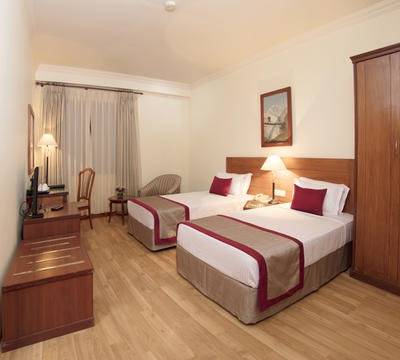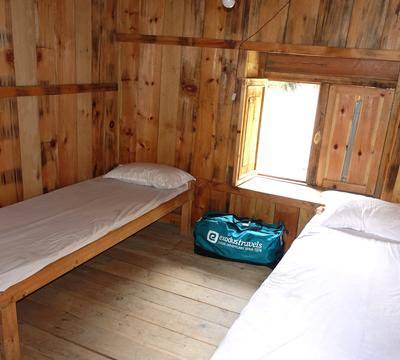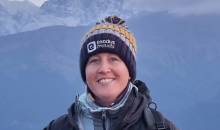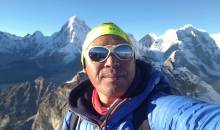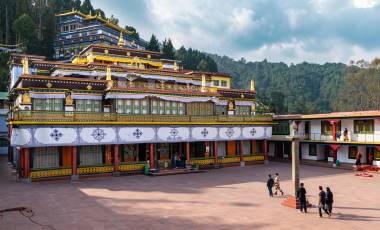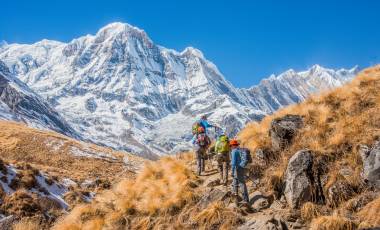- Take a magnificent off-the-beaten-track circular trek around Manaslu
- Cross the remote Larkya La
- Enjoy rare views of Manaslu
- Trek through picturesque traditional Tibetan villages
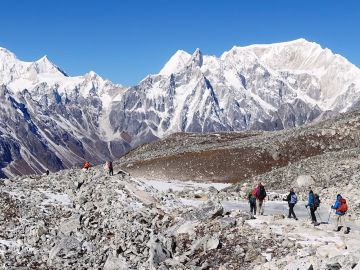
Manaslu Lodge Circuit
- Home
- Asia
- Nepal
- Walking & Trekking
- Manaslu Lodge Circuit
Extend Your Trip
Chitwan or Kathmandu Valley Add-on Tours
 Extend your adventure by joining one of our add on tours:
Extend your adventure by joining one of our add on tours:
Chitwan: This five-day wildlife adventure is a perfect chance to unwind in Nepal’s lowlands after your trek. From Kathmandu, travel to your jungle lodge near Chitwan National Park, where an expert naturalist will help you spot one-horned rhinos, birds, deer and more. See the full itinerary here.
Kathmandu Valley: Nestled in the Himalayan foothills, the Kathmandu Valley is a perfect prelude to your adventure. This short trek starts and ends in Kathmandu, with gentle trails through villages and rhododendron forests, and sweeping mountain views. See the full itinerary here.
Reviews
Add your own reviewExcellent Hiking Experience
This was a great trip, first and formost due to the very professional and experienced support team lead by Kumar.
Most Inspirational Moment
The morning after passing Larke Pass. After a very cold night, we found ourselves surrounded by a beautiful mountain panorama.
Thoughts on Group Leader
Absolutely brilliant ! I can’t praise Kumar high enough. His default reply to pretty much all our needs and questions was positive and he made it happen. Always attentive and during thye whole trip super professional and helpful.
Advice for Potential Travellers
Make sure that you bring a good sleeping bag !
An outstanding glimpse into the past
I last trekked in Nepal 35 years ago, when there were no roads in the mountains and everything was carried on the backs of humans or mules. In the intervening years I had become increasingly reluctant to return, watching the gradual encroachment of the car into these pristine areas, but the Exodus PR for this trip was too good to resist. I was not disappointed. Once we had left the “railhead” end of the road behind, we were back into a land of mule trains, farming and herding, in a chaotic wilderness of gorges, waterfalls, landslides and suspension bridges leading to the wild uplands at the snow line, a slow but remarkable change in geology, architecture, religion and culture as we climbed further and further away from the lowlands.
I can’t imagine a better insight than this trip into the differences in lived experience of those of us who live in the northern hemisphere (or even between those who live in Kathmandu and the mountains).
Most Inspirational Moment
For a one-off inspiration: seeing yak herders on the open mountainside collecting yak dung for fuel and realising that a way of life which has existed for hundreds of years is still practised. For the more gradual inspiration more appropriate to a long-distance walk, it was the slow change in colour and vegetation from late summer in the lowlands to autumn in the uplands. For the small things in life it was realising in Samdo at 3,860 m that the sun on the tin roof of the shower cabin outside the teahouse meant that a hot bucket shower was not only possible but actually desirable.
Thoughts on Group Leader
I have been on many Exodus trips, but for sheer unconfined, unabashed, joyful exuberance and enthusiasm Chandra takes the prize. The image of him singing and dancing in the local bus on the way back from the end of the trip, as we swayed and lurched millimeters away from a drop of hundreds of metres into the gorge below will stay with me for the rest of my life. In terms of practical competence, the three trekking guides we had were outstanding: Prasan (the head guide), Sagar and Mingma.
Advice for Potential Travellers
If your fitness is not permanently high, make sure you do (as a minimum of preparation) the Exodus training plan. Then you won't notice the long distances and hard ascents and will have plenty of time to take in what you are walking through. Don't arrive expecting to be able to buy the snow spikes from the guide as you can't: you will need to walk into Thamel to get some. If you want to save space on your packing for the flight, the down jackets and sleeping bags you can hire from the guides are really good quality.
Manaslu Circuit quiet and authentically enchanting.
A beautiful journey with a great variety of culture and landscape from agricultural to forest and mountain scenery. It’s a peaceful trek away from crowded routes but get there as soon as you can before the road that is being built changes everything. The route is occasionally just a little exposed due to landslides caused by the recent long monsoon. A gentle acclimatisation schedule leads up to highest point at Larkya La just a little over 5000m. There are wonderful mountain views of Manaslu from a number of various aspects and distances.
Most Inspirational Moment
Being lucky enough to be on this trip with of our wonderful guide Valerie Parkinson who was the first British woman to complete a successful Manaslu ascent without oxygen. Her bedtime stories of her mountain adventures kept us enthralled. .
Thoughts on Group Leader
I have travelled previously with Valerie and her gentle encouragement, expert care, attention to detail and ability to keep an entire group motivated, combined with keeping expectations realistic, led to an unforgettable and happy experience for all of us.
Advice for Potential Travellers
Get friendly and make connections with the local guides, porters and the lodge owners to genuinely enhance your understanding of what goes into making these trips work so well. Some of the lodges are quite basic so please don’t expect too much in terms of amenity or comfort. However, I was genuinely surprised that some had Wi-Fi (payable),decent hot showers (payable) and occasional power sockets (free) in the rooms to keep devices charged up and that really did feel like luxury!
Fantastic Scenery but tougher than Annapurna Circuit
This is an amazing trip which, unlike the Annapurna Circuit (which I did in 2019) brings you far closer to the big mountains including the 8,000 metre massif of Manaslu. Due to the recent hard monsoon on 2022 the trail had been recently modified and included a number of narrow paths across landslides (think traversing high screes in rthe UK) which wouldn’t be to everyone’s tastes but were necessary in the circumstances. The Manaslu Circuit is much quieter than the Annapurna Circuit, takes in a lot more villages and general culture of Nepal and doesn’t include the dusty main roads that seem a feature of the Annapurna Circuit nowadays. As such, the whole group found it more authentic, the scenery a lot more spectacular and a thoroughly enjoyable trip from start to finish. In teh Exodus brochure it has teh same difficulty rating as the Annapurna Circuit but our group thought it was a few grades harder and because of the time of the year we were wearing crampons for 4-5 hours on the ‘pass day’ due to amount of compacted snow on the ground. A thoroughly memorable trip in an amazing region.
Most Inspirational Moment
We had a number of health issues within the group due to the altitude, cold and a few bugs which spread around. The way the group, which was largely the same as on the Annapurna Circuit in 2019, pulled together and everyone supported each other was inspirational. It just goes to show that when you get really good people around you it makes a huge difference and we all felt that a bit of adversity helped the group really bond together
Thoughts on Group Leader
We wre a tailormade trip so we requested to have Tsering Dorje Sherpa as our Guide as he was the guide on our 2019 Annapurna Trip. We also had Tsering and Kaji who were both multiple 8,000-metre peak summiteers! To say we felt humbled was an understatement but they were all absolutely fantastic and we really appreciated their company, their experience and their shared recollections of time on the big peaks
Advice for Potential Travellers
Read the trip notes well, be prepared for all weathers and eventualities and enjoy it
Manasalu Nov
A challenging and adventurous trip which I thoroughly enjoyed
Most Inspirational Moment
Seeing Manasalu at sunrise
Thoughts on Group Leader
Excellent and very helpful
Advice for Potential Travellers
Make sure you are fit, there are some long trekking days
Amazing adventure with stunning views
3rd time in Nepal after doing Annapurna and Base Camp. This trek was by far the best views of all 3. Tough trek with lots of up and down but well worth it
Most Inspirational Moment
Crossing the high pass after getting up at 2.30am. It was hard but the views are worth it.
Thoughts on Group Leader
Sukman was a great leader. Always happy and smiling and kept our spirits high.
Advice for Potential Travellers
Hardest of all the treks in Nepal so need a good level of fitness. Also take snacks to keep your energy levels up.
Amazing Experience with a Superb Leader
Overall the trip was well planned – mainly due to our leader Sukman Pakhrin. Sukman and the experienced guides supported us as a whole group through the trip, managing difficulties of skills, illness and being on hand 24/7. Even after an exhausting day Sukman organised arrival teas, organised dinner, beds, paying bills and with a positive attitude inspired us all for the next days adventure of trials and difficulties. Giving us clear understanding of next days adventure, Sukman was the glue that made the team great and worked together well. I can’t thank Sukman and his guides enough for the patience he offered me for helping me get over the pass as I found that day really challenging. Thank you Karen
Most Inspirational Moment
Getting over the pass with a chest infection
Thoughts on Group Leader
amazing leader and couldn't thank him enough for his patience on my difficult day
Advice for Potential Travellers
be prepared for hard and some long days
5 years and 4 rebooking’s later finally completed the trek and it was so worth the wait!
It is hard to summarize such a great trek, with outstanding leadership (Bikash/Kushman) and trail buddies, but I’ll try. Having trekked in the Everest Region twice with Exodus (2015/2017), I didn’t know if the Manaslu Circuit trek could match those experiences – it did and even surpassed them in some areas. The trip notes are pretty spot on with regards to the trek and while the road continues to push further, our guides did a great job of avoiding it in parts and minimizing the road sections. As a result, it doesn’t really dimmish the trek (yet), which is still remote and goes through multiple climate and cultural zones as you ascend to, and descend from, Larke La. It is very hot at the lower altitudes and it is cold at the around the pass – so you have to pack accordingly. The daily schedule works very well and we had no acclimatization issues within the group, which was of varied ages and experience. The scenery is dramatic and ever-changing, the views of Manaslu are excellent – showing its different faces over multiple days. Take advantage of the acclimatization opportunities and in Samagaun and Samdo do make an effort to get into the heart of the villages as the culture and architecture is authentic and you can see daily life play out. Make sure you visit Birendra Tal outside Samaguan. The lodges were good but mostly more basic than the Khumbu. Dharamsala is no longer just tents but is still very basic. So happy to have completed this trek with Exodus – 192miles / 32,000ft of ascent over 14 days, with a high point of 16,945ft/5165m.
Most Inspirational Moment
Three things for me personally – 1) crossing the Larke La and being over 5000m again, 2) the rest day in Bhimtang was so welcome with great weather, views, and a quiet teahouse, and 3) the last night's celebration in Bhundanda, which fell on Nepali New Year, so much drinking and dancing – never to be forgotten!
Thoughts on Group Leader
Bikash was an outstanding leader. Always present, always well organized, always supportive and encouraging. Above all reassuring and confident. I’d trek with him and Kushman, our guide, again anytime. Our porters were great people also.
Advice for Potential Travellers
Do it – this is an outstanding trek for so many reasons. Be patient in the first couple of days as it is very hot and the road plays its part, but that’s all quickly forgotten as you push on.
Walking the quieter circuit brings its own reward.
This is a fantastic trek through scenery varying from: farmland, forests of pine trees, walking along river gorges beside foaming rivers, through villages full of character and smiling children and finally beside amazing snow clad high mountain peaks. All of which we did with very few other trekkers.
Most Inspirational Moment
Walking up to the Larkya Pass as the dawn slowly broke behind us revealing snow covered mountains all around.
Thoughts on Group Leader
As always Valerie looked after us really well and added that bit extra to the enjoyment of the trip. This time sharing her experiences of climbing Manaslu by reading excerpts from her diary of the trip.
Advice for Potential Travellers
I was pleasantly surprised with my first experience of a lodge (Teahouse) based trip. Remember you need to budget for buying your own lunches and evening meals on this trip but the food available is tasty and the choice varied enough to cover most desires. if you need a 'pick me up' along the way then try the Apple Fritters with Custard! Although the rooms in the lodges are basic they were all clean and the beds comfortable. Remember a supply of wet wipes for the nights when it is too cool for a proper wash.
Highly recommend this trek.
This is my fifth trek in Nepal and definitely my favourite. Happy to have done this before the road is complete as this will change the remote nature of this trek.
We had a fantastic group who supported each other, particularly on the day crossing the pass.
This trek is more challenging than Annapurna Circuit and Gokyo/Everest.
Our guide Keshar was simply the best, can’t say enough about him. Also great to have Zoe from Exodus London office as my roommate. I feel very fortunate to have been on this trek.
Most Inspirational Moment
Hard to choose as each day was inspirational for different reasons.
Start
Finish
Availability
Land Only Trip Price
Optional Single Supplement
Thursday Wednesday
16 Oct 2025 15 Oct 2025
Sunday Sunday
02 Nov 2025 02 Nov 2025
Availability
Guaranteed (Available)
Land Only Trip Price Usually £ 2349Now £ 2099Saving £ 250 Usually £ 2349Now £ 2099Saving £ 250
Optional Single Supplement +£ 140
Availability
This departure is available for new bookings and has reached the minimum number of passengers required to go ahead. Please click Continue to proceed with booking or contact our Sales team for assistance.
View Trip NotesThursday Wednesday
06 Nov 2025 05 Nov 2025
Sunday Sunday
23 Nov 2025 23 Nov 2025
Availability
Guaranteed (Available)
Land Only Trip Price Usually £ 2899Now £ 2649Saving £ 250 Usually £ 2899Now £ 2649Saving £ 250
Optional Single Supplement +£ 140
Availability
This departure is available for new bookings and has reached the minimum number of passengers required to go ahead. Please click Continue to proceed with booking or contact our Sales team for assistance.
View Trip NotesThursday Wednesday
20 Nov 2025 19 Nov 2025
Sunday Sunday
07 Dec 2025 07 Dec 2025
Availability
Guaranteed (Available)
Land Only Trip Price Usually £ 2349Now £ 2149Saving £ 200 Usually £ 2349Now £ 2149Saving £ 200 Book with £ 537 deposit Book with £ 537 deposit
Optional Single Supplement +£ 140
Availability
This departure is available for new bookings and has reached the minimum number of passengers required to go ahead. Please click Continue to proceed with booking or contact our Sales team for assistance.
View Trip NotesThursday Wednesday
19 Mar 2026 18 Mar 2026
Sunday Sunday
05 Apr 2026 05 Apr 2026
Availability
Guaranteed (Available)
Land Only Trip Price £ 2949 £ 2949 Book with £ 737 deposit Book with £ 737 deposit
Optional Single Supplement +£ 160
Availability
This departure is available for new bookings and has reached the minimum number of passengers required to go ahead. Please click Continue to proceed with booking or contact our Sales team for assistance.
View Trip NotesThursday Wednesday
26 Mar 2026 25 Mar 2026
Sunday Sunday
12 Apr 2026 12 Apr 2026
Availability
Guaranteed (Available)
Land Only Trip Price £ 2499 £ 2499 Book with £ 624 deposit Book with £ 624 deposit
Optional Single Supplement +£ 160
Availability
This departure is available for new bookings and has reached the minimum number of passengers required to go ahead. Please click Continue to proceed with booking or contact our Sales team for assistance.
View Trip NotesThursday Wednesday
16 Apr 2026 15 Apr 2026
Sunday Sunday
03 May 2026 03 May 2026
Availability
Guaranteed (Available)
Land Only Trip Price £ 2299 £ 2299 Book with £ 574 deposit Book with £ 574 deposit
Optional Single Supplement +£ 160
Availability
This departure is available for new bookings and has reached the minimum number of passengers required to go ahead. Please click Continue to proceed with booking or contact our Sales team for assistance.
View Trip NotesThursday Wednesday
08 Oct 2026 07 Oct 2026
Sunday Sunday
25 Oct 2026 25 Oct 2026
Availability
Available
Land Only Trip Price £ 2399 £ 2399 Book with £ 599 deposit Book with £ 599 deposit
Optional Single Supplement +£ 160
Availability
This departure is available for new bookings, and will be guaranteed to go ahead once it reaches minimum numbers. Please click Continue to proceed with booking or contact our Sales team for assistance.
View Trip NotesThursday Wednesday
15 Oct 2026 14 Oct 2026
Sunday Sunday
01 Nov 2026 01 Nov 2026
Availability
Guaranteed (Available)
Land Only Trip Price £ 2399 £ 2399 Book with £ 599 deposit Book with £ 599 deposit
Optional Single Supplement +£ 160
Availability
This departure is available for new bookings and has reached the minimum number of passengers required to go ahead. Please click Continue to proceed with booking or contact our Sales team for assistance.
View Trip NotesThursday Wednesday
22 Oct 2026 21 Oct 2026
Sunday Sunday
08 Nov 2026 08 Nov 2026
Availability
Available
Land Only Trip Price £ 2399 £ 2399 Book with £ 599 deposit Book with £ 599 deposit
Optional Single Supplement +£ 160
Availability
This departure is available for new bookings, and will be guaranteed to go ahead once it reaches minimum numbers. Please click Continue to proceed with booking or contact our Sales team for assistance.
View Trip NotesThursday Wednesday
05 Nov 2026 04 Nov 2026
Sunday Sunday
22 Nov 2026 22 Nov 2026
Availability
Available
Land Only Trip Price £ 2399 £ 2399 Book with £ 599 deposit Book with £ 599 deposit
Optional Single Supplement +£ 160
Availability
This departure is available for new bookings, and will be guaranteed to go ahead once it reaches minimum numbers. Please click Continue to proceed with booking or contact our Sales team for assistance.
View Trip NotesThursday Wednesday
12 Nov 2026 11 Nov 2026
Sunday Sunday
29 Nov 2026 29 Nov 2026
Availability
Guaranteed (Available)
Land Only Trip Price £ 2999 £ 2999 Book with £ 749 deposit Book with £ 749 deposit
Optional Single Supplement +£ 160
Availability
This departure is available for new bookings and has reached the minimum number of passengers required to go ahead. Please click Continue to proceed with booking or contact our Sales team for assistance.
View Trip NotesThursday Wednesday
19 Nov 2026 18 Nov 2026
Sunday Sunday
06 Dec 2026 06 Dec 2026
Availability
Available
Land Only Trip Price £ 2399 £ 2399 Book with £ 599 deposit Book with £ 599 deposit
Optional Single Supplement +£ 160
Availability
This departure is available for new bookings, and will be guaranteed to go ahead once it reaches minimum numbers. Please click Continue to proceed with booking or contact our Sales team for assistance.
View Trip NotesThursday Wednesday
03 Dec 2026 02 Dec 2026
Sunday Sunday
20 Dec 2026 20 Dec 2026
Availability
Available
Land Only Trip Price £ 2399 £ 2399 Book with £ 599 deposit Book with £ 599 deposit
Optional Single Supplement +£ 160
Availability
This departure is available for new bookings, and will be guaranteed to go ahead once it reaches minimum numbers. Please click Continue to proceed with booking or contact our Sales team for assistance.
View Trip NotesYou may also like
The Adventure Begins Here
Get regular inspiration straight to your inbox from Exodus’ experts.


